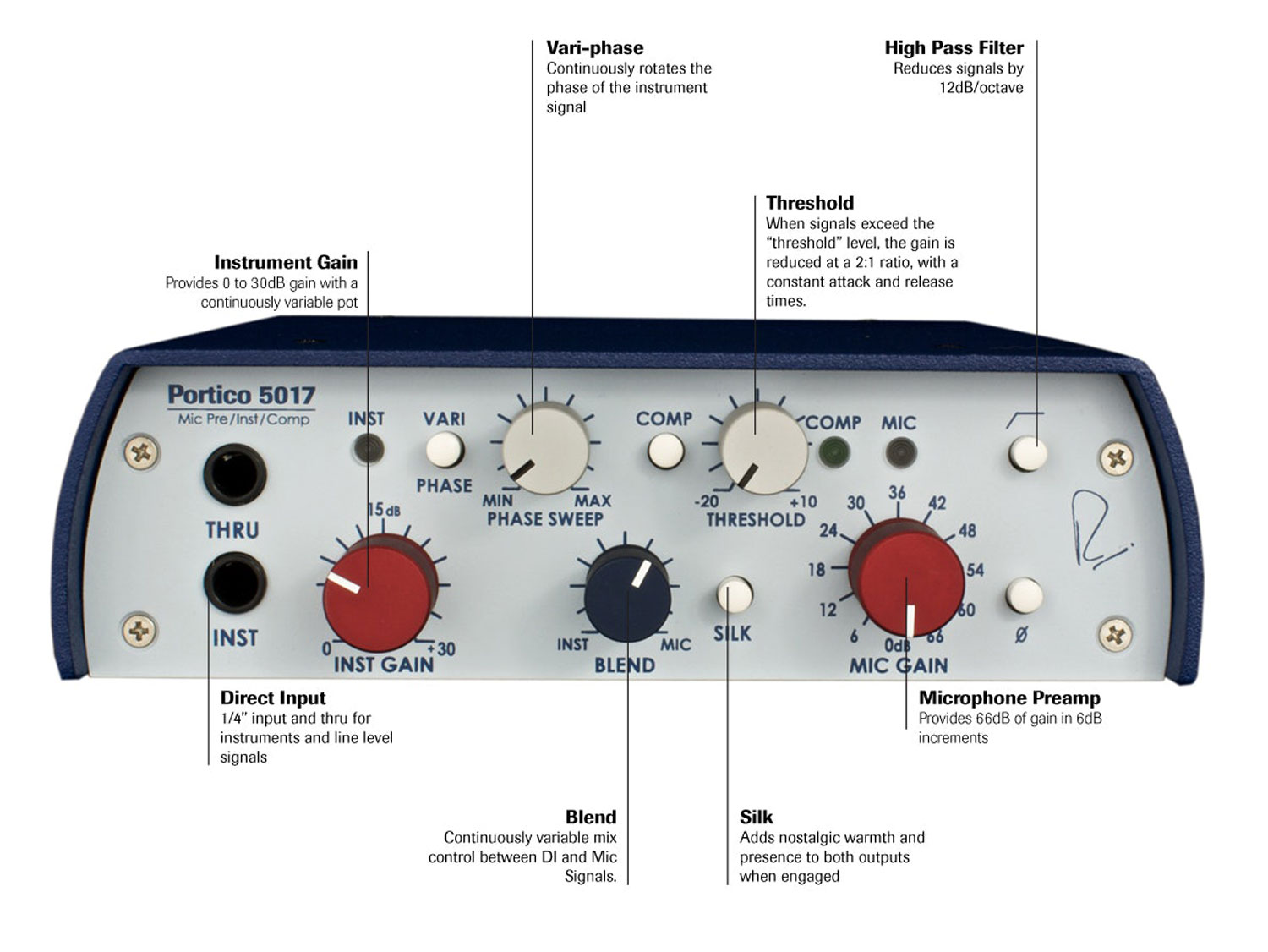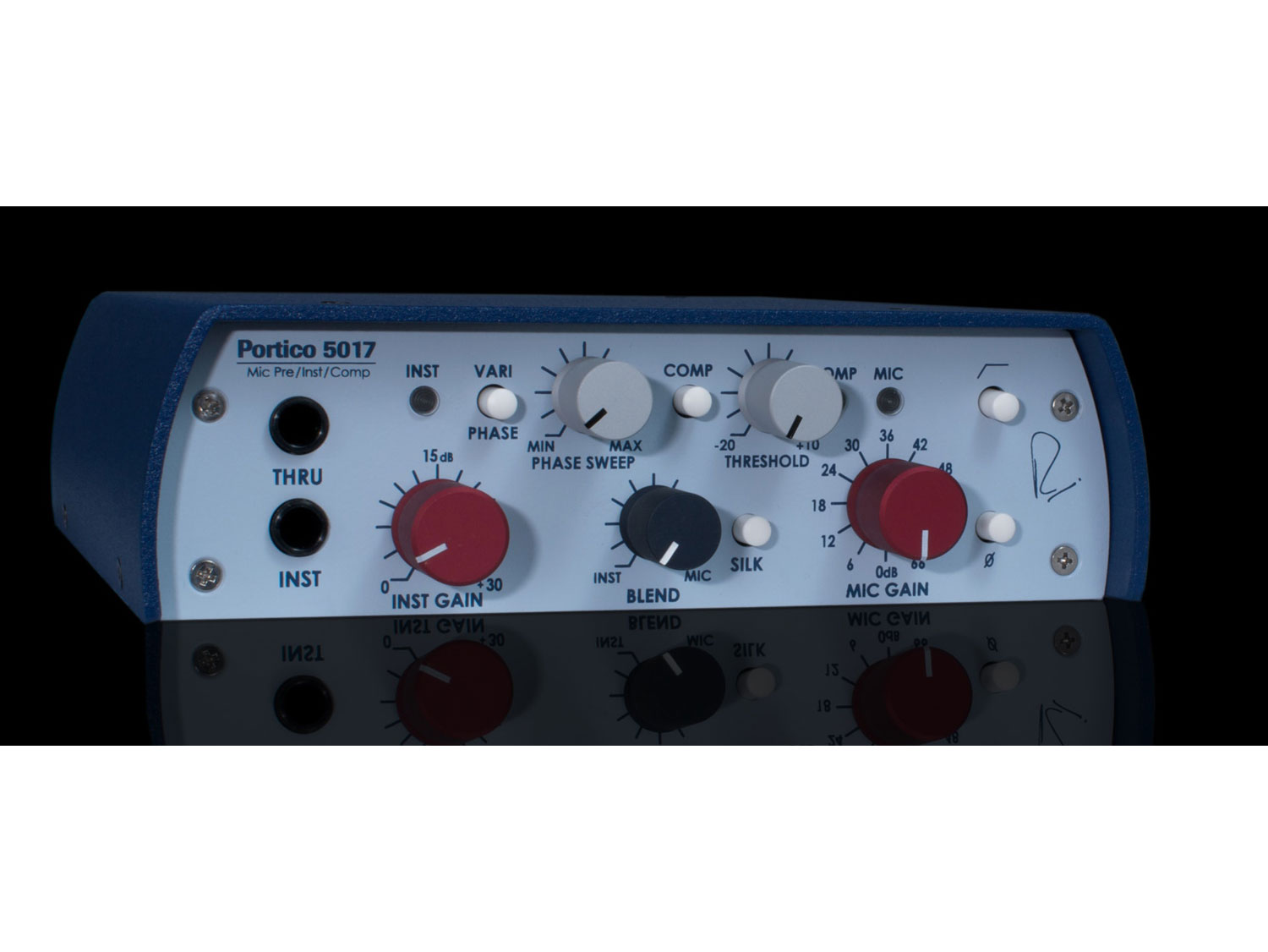Rupert Neve Designs Portico 5017 Mic Pre / Comp / DI
With Portico Series custom transformers and silk mode, the Mobile DPC’s sonic signature is nothing short of legendary. It’s the 5017’s revolutionary feature set however that make it an indispensable tool for studio recording, live recording and stage performances.
Dual Channel Use
Used as a two channel device, a lead singer and guitar player, can take the classic studio quality of the 5017 wherever they go; using the DPC for a Vocal mic pre and compressor, as well as a separate DI preamplifier. To achieve this, the blend control should be selected as fully DI (blend off), and an internal jumper can be selected to apply the compressor to the mic pre signal. When engaged, Silk mode would effect both vocal and guitar tracks, and the HPF control would effect only the mic path.
Blended Use
Used as a single channel device for instruments, the 5017 can be used to phase align, combine and compress direct and amplified signals. To achieve this, use the DI for the instrument’s direct signal and the mic preamp for the speaker cabinet signal. The blend control is used for mixing direct and amplified signals to achieve the desired tonal blend between the two sources, and the variphase is used to minimize or extenuate phase cancellations between the two signals. To compress the blended signal, the internal compressor jumper must be set to the blend path (this is the default setting). This technique could also be used to create a single, mixed output of a guitar and vocals.
The Compressor
Based around a new LDR (light dependent resister) design, the 5017’s opto-coupler compressor has been simplified to a single threshold control with auto make up gain. By default, the compressor is set to a fixed 2:1 ratio with an internal jumper to change between standard and fast time constants. To set the compressor, simply dial the threshold control down until the desired amount of compression is achieved. An LED light indicates when the compressor is active.
Vari-Phase
In addition to the standard polarity reverse, the 5017 also incorporates a vari-phase control to adjust the phase incrementally. This control is useful any time two signals derived from the same source are combined.
For instance, even with careful placement, the combination of close miced drums and overheads, can often yield hollow sounding results. By using the variable phase adjust, the direct signal can be phase rotated until the signals are naturally aligned.
This technique is also extremely useful when combined with the internal blend control on instruments. A bassist, using both direct and miced signals can blend the two into a single output, using the vari-phase to reach an optimal alignment. By adjusting the phase in the 5017, the musician or engineer can find the absolute best mic position without regard to the phase relation to the direct signal.
Tech Specs
Dimensions
- 7.5” (deep) x 6.5” (wide) x 2” (high)
Frequency Response:
Main Output, no load,
- –0.2 dB @ 10 Hz
- –3 dB @ 160 kHz
Noise:
Measured at Main Output, unweighted, 22Hz-22kHz,Terminated 150 Ohms.
- With gain at unity better than –100 dBu
- With gain at 66 dB better than –62 dBu
- Equivalent Input Noise better than –128 dBu
- Noise Factor 1.5dB
Maximum Output Level:
- Maximum output from 20 Hz to 40 kHz is +23 dBu.
Total Harmonic Distortion and Noise:
- @ 1kHz, +20 dBu output: Main Output: Better than 0.001%
- @ 20Hz, +20 dBu output: Main Output: Better than 0.002%
- Silk Engaged: Better than 0.2% Second harmonic
Crosstalk:
- Measured channel to channel: Better than –90 dB @ 15kHz.
Phantom Power:
- +48 Volts DC +/- 1%



